Stocks were higher in the first quarter of 2024, continuing their winning ways that started in the fourth quarter of last year. Despite an up quarter overall, the MCM Thematic Growth Composite underperformed the broader S&P 500 Total Return Index.
In the first quarter, the MCM Thematic Growth Composite increased by 2.8% net of costs and inclusive of dividends versus an S&P 500 total return index gain of 10.6%. This was an evident disappointment, and as a result, we have slipped against the S&P 500 total return over the five past years, with annualized gains of 13.32% versus the S&P 500 total return annualized gains of 15.05%

The quarter’s underperformance resulted from two factors: a concentration of performance in just a few stocks in the overall S&P 500 and—more importantly—my cautious view based on a fundamental analysis of the broader market, which is at the heart of the Thematic Growth Fund philosophy.
Nvidia’s Impacts on The Market
In the first quarter, Nvidia (NASDAQ:NVDA) was responsible for 11.02% of the returns in the S&P 500 total return index, followed by Microsoft's (NASDAQ:MSFT) 3.69%, Meta's (NASDAQ:META) 3.20%, and Amazon's (NASDAQ:AMZN) 2.83% contributions. Of course, we own Microsoft and Amazon and benefited from those positions. However, they could not offset the declines witnessed by our other holdings during the period.
Apple (NASDAQ:AAPL) was the weakest contributor to the S&P index in the first quarter, subtracting 3.32%, followed by Tesla's (NASDAQ:TSLA) 2.20%, Adobe's (NASDAQ:ADBE) 0.46%, and Boeing's (NYSE:BA) 0.42%.
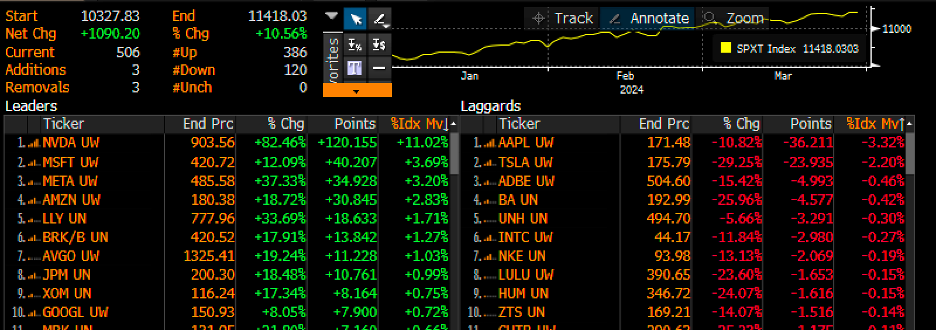
(Bloomberg)
For us, it came down to owning too few “right” stocks in a market driven mainly by a few individual issues while maintaining a higher-than-normal cash balance.
That said, a cautious, somewhat defensive position is the correct course for the Thematic Growth strategy. With the market being dangerously driven by an Artificial Intelligence momentum trade, valuations very high, and interest rates at their highest levels in decades, there are too many fundamental signals to be optimistic about the strength of this market, and certainly enough evidence to be wary about short-term investment outlook.
The most significant risk to this market presently doesn’t seem to be the economy but Nvidia. Nvidia has been the most critical contributor to the gains in the market in 2024. The company is due to report results on May 22, with the first anniversary of its breakout from the launch of its AI chip. Revenue growth rates should begin to slow dramatically in the coming quarters, which could be one reason the stock has stalled in recent weeks, with growth expected to slow.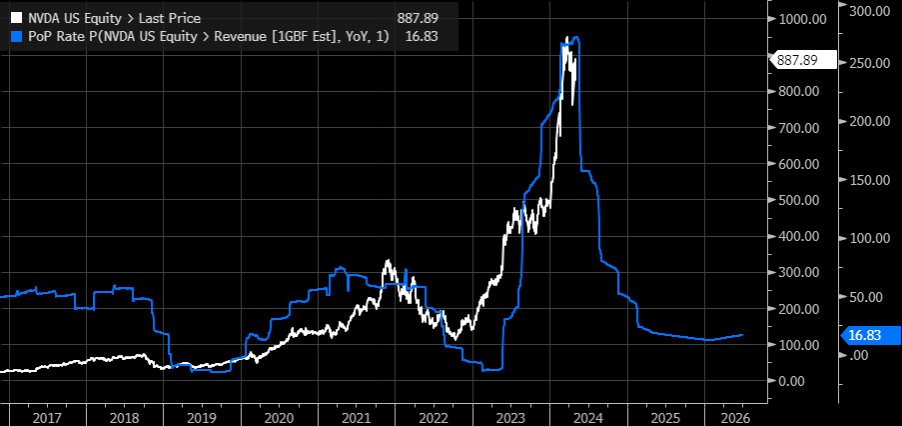
(Bloomberg) – Nvidia’s stock price versus expected sales growth
Usually, I would not discuss a stock we don’t own. However, given how vital this stock has been to the index and the market’s overall performance, where it goes from here will significantly impact the overall market trends.
Additionally, because the stock is the third largest in the S&P 500, which is market cap-weighted, its earnings and revenue growth have helped support overall earnings estimates for the S&P 500.
So, a lot is riding on this AI momentum trade now, and whether that rally can continue is questionable. It seems to be a momentum-based rally because many companies are spending a lot on AI but aren’t necessarily seeing the benefit of AI in greater revenue. In contrast, only a handful, mostly Nvidia, seem to be.
Higher Rates and Sticky Inflation Pose Risks
More fundamentally, we are dealing with a market that appears to be overvalued when considering where Treasury rates are currently. This is especially true given that inflation remains sticky in the mid-3% range, which likely means that rates will remain higher for a more extended period.
S&P 500 earnings are expected to grow 11.4% over the next 52 weeks, while the risk-free rate is around 4.5%. That means the expected earnings growth rate above the risk-free is around 6.9%. For that, investors are paying about 20.1 times earnings. The risk-adjusted growth rate was higher from early 2017 until late 2018, and the PE ratio was lower. Meanwhile, in 2021, the PE ratio was around 21, with a rate of growth above the risk-free well above 20%, based on the nearly zero federal funds rate.
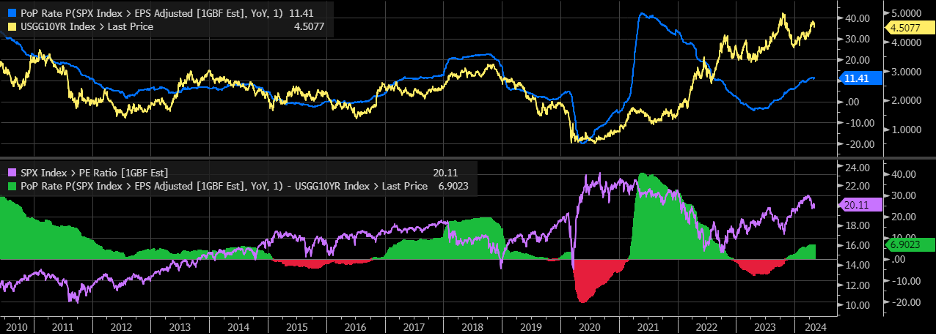
(Bloomberg) S&P 500 expected growth less the 10-Yr Treasury versus the PE Ratio
This tells us we are paying a high premium to own stocks and not getting much back in return. This is not to say that all stocks in the market are expensive. However, the problem is that should the market turn lower, stocks tend to become more correlated, which means that if some go down, there is a good chance that many go down.
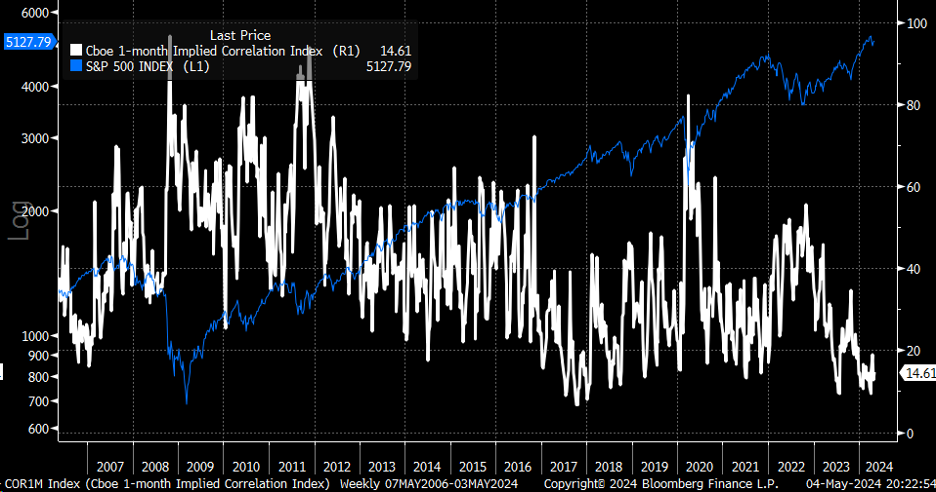
(Bloomberg) The S&P 500 vs the 1-Month Implied Correlation Index
There is a good argument that stock values will, in fact, retreat. At this point, nominal GDP growth is outpacing money supply growth, and because of that, the velocity of money is rising. When the velocity of money rises, you get inflation, as the pace of one dollar moving through the economy increases. If nominal GDP grows faster than the money supply, the velocity of money will continue to rise, and inflation will remain.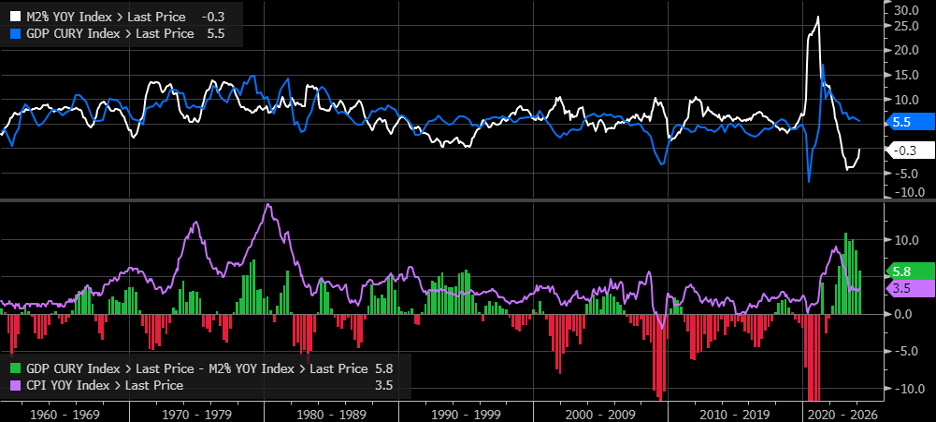
(Bloomberg) Nominal GDP Growth Rate Vs. M2 Growth Rate vs. Consumer Price Index
The velocity of money is highly correlated to bond yields. As long as the dynamic of faster money velocity continues with nominal GDP growing as fast as it is and the money supply not growing at all, bond yields will likely continue to rise.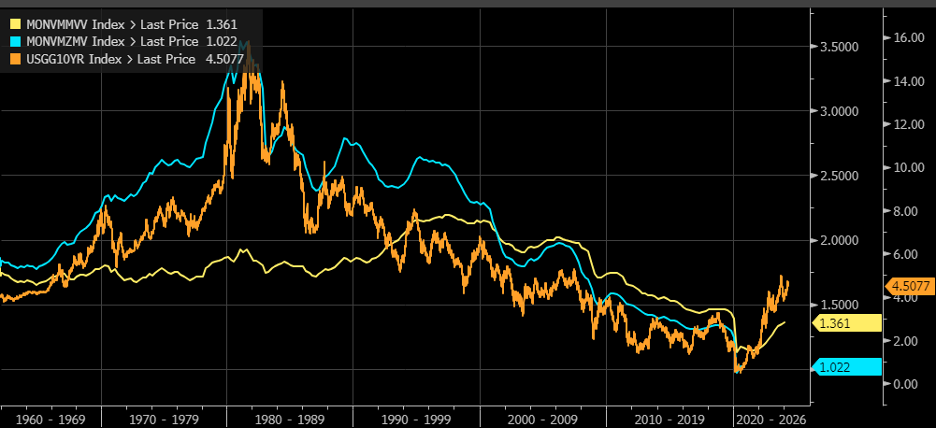
(Bloomberg)Velocity of M2 and MZM vs. 10-Year Treasury Rate
So, if bond yields remain elevated and potentially go higher, the only thing keeping equities afloat is the risk investors are willing to take. Notably, high-yield credit spreads are as narrow today as when the interest rates were at 0%, and the Fed was pumping $120 billion into the economy through Quantitative Easing. Because credit spreads are low, it tells us that investors are willing to take on more risk, and equities reflect this with a higher PE ratio. The PE, when inversed, is called the earnings yield, and right now, the earnings yield of the S&P 500 is low on a historical basis. There are better environments to pursue new positions aggressively.
Portfolio Review
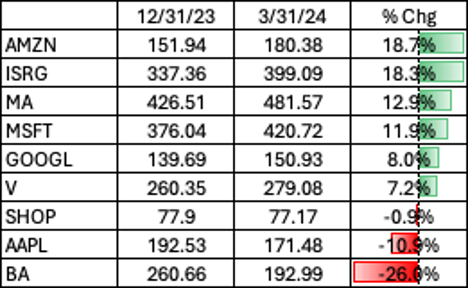
As for our holdings, it wasn’t a great quarter. Boeing was in the news and down a lot, and it was clearly the biggest drag on our performance. Despite the negative headlines and concerns over some of their planes, I continue to hold on to Boeing because the stock is still far above our purchase price, and there are no other significant players in this space. They operate in a duopoly, and at this point, I don’t see anyone else coming to take market share from them.
Apple also experienced a significant drawdown in the first quarter due to concern over iPhone sales in China and sluggish growth expectations. Overall, Apple is a well-positioned company that continues to create devices that integrate well with one another, making transferring devices within the ecosystem seamless. Plus, once a customer enters the Apple ecosystem, moving to a new ecosystem is tough without uprooting much of their life and leaving many memories behind.
Amazon had a fantastic quarter, and that is due to the rebound in its Amazon Web Services business. Additionally, they seem to have expenses again under control, leading to expanding margins. Cash flow from operations has moved to new highs, and the stock tends to follow cash flow from operations over time.
Alphabet (NASDAQ:GOOGL) and Microsoft delivered solid quarters and continue to be our core holdings. Despite their inability to keep up with the index this quarter, I see no reason to unload them either. Meanwhile, Visa (NYSE:V) and Mastercard (NYSE:MA) continue to perform well, as they have for years.
Intuitive Surgical (NASDAQ:ISRG) was a fantastic addition to the portfolio in 2022. It has performed exceptionally well and continues to do so. It continues to see strong procedure growth and plans to roll out a new DaVinci 5 robotic surgery system.
Overall, the portfolio is positioned to deliver long-term growth. While the recent quarter was disappointing, I firmly believe that now remains a tricky market moment. I have learned over time that overpaying for stocks in the present means underperformance in the future.
That said, I have a list of names I have put together that I think have already seen rather sharp declines over the past two or so years and haven’t benefited from the current AI mania. But for now, cash balances remain elevated. When market pullbacks bring valuation back into better long-term alignment, I will be an aggressive buyer of stocks and look to decrease our cash positions, bringing that target back to 5%, which would be a fully invested portfolio.
